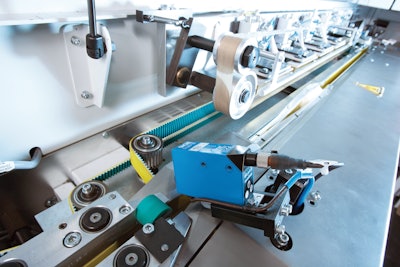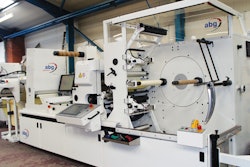A tightly integrated array of photoelectric proximity sensors, fiber-optic sensors, inductive proximity sensors, laser sensors, contrast sensors, and safety locking devices plays a crucial role in a remarkable piece of equipment from Germany’s Winkler & Dünnebier. Called the Flowtos, this equipment is described as the fastest two-lane paper handkerchief production and packaging system in the world. It’s capable of producing and flow wrapping up to 4,600 sheets per minute.
All of the sensor devices on the Flowtos are supplied by SICK AG. Product quality stands at the top of the list of reasons for specifying SICK, says W+D. But also important is how easily the sensors can be integrated and SICK’s ability to incorporate custom requirements. Add to these a successful track record of cooperation between W+D and SICK over many years and it becomes pretty clear why a single supplier is behind the many sensors the Flowtos requires.
“The Flowtos tissue machine is four times faster than a machine gun,” says Frank Jungbluth, Electrical Engineering Project Manager for the Flowtos at W+D. “It goes without saying that the sensors used in the machine need to work reliably because every minute of downtime immediately has an impact in terms of performance and money.”
The functional complexity of the Flowtos is what requires such a wide variety of sensors, which differ significantly in their physical operating principles. “It was, therefore, important for us to be able to purchase all the sensors we needed from a single source—a source that could also provide support and advice, as well as offering us the ideal solution for every application,” says Jungbluth. “We also wanted to avoid taking risks where the actual provision of sensor technology and delivery reliability were concerned. Thanks to our long-standing cooperation with SICK, we knew we could rely on them.” A total of more than 40 sensors are integrated in the machine, adds Jungbluth.
A part of the Korber Group, W+D also has a Mail Solutions group, which specializes in system solutons for manufacturing, printing, inserting, and packaging envelope-based products. W+D’s Hygiene Solutions segment, on the other hand, is all about making and packaging tissue-fold and hygiene products. “With the Flowtos, we are not simply offering a complete solution for the production of tissues, we are also implementing an innovative engineering concept,” says Jungbluth. “The machine is fully fitted with servo technology and electronics, making it extremely flexible and allowing our customers to produce a wide range of different sizes and packages.”
Controls platform is a key
The Flowtos represents a complete departure in its category partly because of the way it combines speed, modularity, and change-on-the-fly flexibility—all in a remarkably compact footprint. Decentralized IndraDrive servo drive technology from Bosch Rexroth plays a big role by minimizing cabinet space and cooling for the 45 or so servo drives that are in place. It also make plug-in modules possible by connecting the sensors directly to the drives in the machine with preconfigured cables. Additional I/O are linked with bus couplers via the decoupling option at the drives. This significantly reduces cabling effort while also speeding up commissioning and start-up.
The Flowtos from W+D is a two-lane tissue machine for two-, three-, or four-ply tissue production with an integrated packaging and bundling system. It is possible to electronically preselect stacks of between 5 and 15 tissues as well as the number of individual packages—between 6 and 56. “The machine’s production and packaging technology doesn’t just offer maximum flexibility with respect to size and the number of tissues in each stack, it also minimizes the change-over times when switching between standard and compact folded products in pocket-sized versions,” says Jungbluth. “Thanks to its modular construction and the way the functional units are linked in a u-shape—from the unrolling station to the bundling system—the Flowtos is extremely easy to access for operation, cleaning, and maintenance. And just as efficient in its operation is the integrated sensor technology from SICK. It ensures that the individual process steps run smoothly and with an optimum level of integration.”
The Flowtos is made up of a sequence of modules: an unrolling station, a smoothing and compressing station, a cutting/folding/stacking unit, and an individual packaging system with an integrated turning and bundling station. In the unrolling station, tissue material is unraveled from a roll approximately 2m in diameter. The diameter of the roll as it is being unrolled is continuously monitored by a WT14-2 photoelectric proximity sensor. The sensor is mounted so that it can move to enable the different core diameters of the rolls to be taken into account, thus allowing it to reliably detect when the end of the roll has been reached. The background suppression function of the WT14-2 ensures reliable detection even in critical environmental conditions.
An additional photoelectric proximity sensor in the unrolling station, a WT18-3, monitors the unrolling process, checking for any rips in the sheet. The sensor’s high level of immunity to ambient light sources and HF lamps in the field guarantees reliable switching behavior. In the smoothing and compressing station, where the tension of the sheet is controlled electronically via servo drives, the tissue is smoothed and compressed in a calender to join the individual layers of tissue together at the edges. To ensure that tissue does not become wound round the calender rollers unintentionally and to detect material residue in the compression area, W+D employs photoelectric proximity sensors from SICK’S VT180-2 product family.
“There were three arguments that spoke in favor of this sensor,” recalls Jungbluth. “The cylindrical M18 design of the metal housing meant that it was easy to integrate. The sensor can reliably differentiate between the shiny surfaces of the rollers and the moving sheet of tissue. And, last but not least, the high switching frequency of 1,000 Hz ensures that the sensor responds quickly and with a minimum loss of material.”
Cut, fold, stack
In the cutting, folding, and stacking module, the compressed sheet of tissue is slit, folded, and fed to a stacking magazine. A WT18-3 photoelectric proximity sensor is integrated in the slitter to scan the sheet of tissue. “This is just one of the areas where the decentralized drive and automation concept of the Flowtos really comes into its own,” says Jungbluth. “The sensors are directly connected to the motor controller. This enabled us to significantly reduce both the cabling required in the machine and the communication load of the automation system.” A WTB8L laser photoelectric proximity sensor then detects the correct length of the cut tissue. W+D engineers were convinced of the sensor’s suitability thanks to its compact design and—due to the small light spot on the material—its highly precise and rapid switching behavior.
Meanwhile, over on the stacking unit, W+D uses WLL180T fiber-optic sensors to monitor the chutes and check for jams. Making these especially suitable are their compact size, fast response times of just 16 µs, and high light intensity and resolution, which ensures optimal functionality in this dusty operating environment. Once a stack of tissues has reached the specified size of ten tissues, for example, it is then transported by conveyor to the flow wrapping unit. Inductive proximity sensors from the IM12 product family have been installed in this section of the conveyor to scan for various positions and end positions. When it came to choosing a sensor, the IM12 stood out thanks to the compact size of its metal housing and its IP67 enclosure rating. Also attractive was that it mounts flush with the surrounding metal and it has high shock and vibration resistance.
In the individual packaging unit, where plastic film of the customer’s choosing is conveyed to wrap the stack of tissues, an IMA18 inductive proximity sensor monitors the position of the dancer roll as the film is unrolled. The sensor has a triple operating distance, allowing it to offer a significantly larger detection range despite being the same size as standard sensors. What’s more, the IMA18 optionally provides an analog current or voltage signal, meaning that the dancer roll position can be continuously monitored within the detection field.
The cutting of the film is triggered by a SICK CS8 color sensor. Thanks to its three-color-LED technology, it is able to reliably detect the register marks that vary in terms of color and background in every situation. As soon as the tissues have been wrapped in film, the packet of tissues reaches the sealing station, where, first of all, the longitudinal seam on the packaging is sealed. Before the packet reaches the turning station, WTB8L laser photoelectric proximity sensors check that the longitudinal seam has been sealed correctly. The packet is then rotated and conveyed to the second sealing unit where the leading and trailing edges of the packet are sealed. Then a sealing label is applied to the opening perforation on the packaging by a labeling machine triggered by a WTB8 miniature photoelectric proximity sensor with background suppression. WL9G photoelectric sensors check that the packet has been sealed correctly.
“These sensors are specially designed to detect transparent objects and materials,” explains Jungbluth. “They can reliably detect whether film is sticking up, which would indicate that the seal is not correct, as well as whether a sealing label is missing.” If a faulty packet of tissues is detected, it is discharged before it reaches the bundling system. The automatic discharge unit is also controlled by a WTB8 miniature photoelectric proximity sensor.
The unrolling station and the entire machine area between the stacking module and turning station prior to the second sealing station are fitted with a protective fence and/or protective covers for reasons relating to machine safety. The access door on the fence of the unrolling station and the mechanical covers in the central machine segment are monitored by safety locking devices from SICK’s i15 Lock product family. Owing to the fact that they are mechanical, spring, and solenoid-locked safety switches with an IP67 enclosure rating and a rugged actuator head, they have also proven themselves to be reliable door-monitoring devices even in the dusty operating environment of the Flowtos tissue machine. They ensure that it is only possible to replace the roll of paper or access the stacking unit, transport path, film unrolling station, and the sealing station when these modules are switched off. They also only allow the modules to be restarted when the mechanical protective devices are closed.
“We have received expert advice and service from SICK experts for what is now more than 25 years,” concludes Jungbluth. “Our queries are always answered promptly and professionally. Assuming their portfolio of products aligns with our needs in the future, we look forward to continuing our close cooperation.”



























